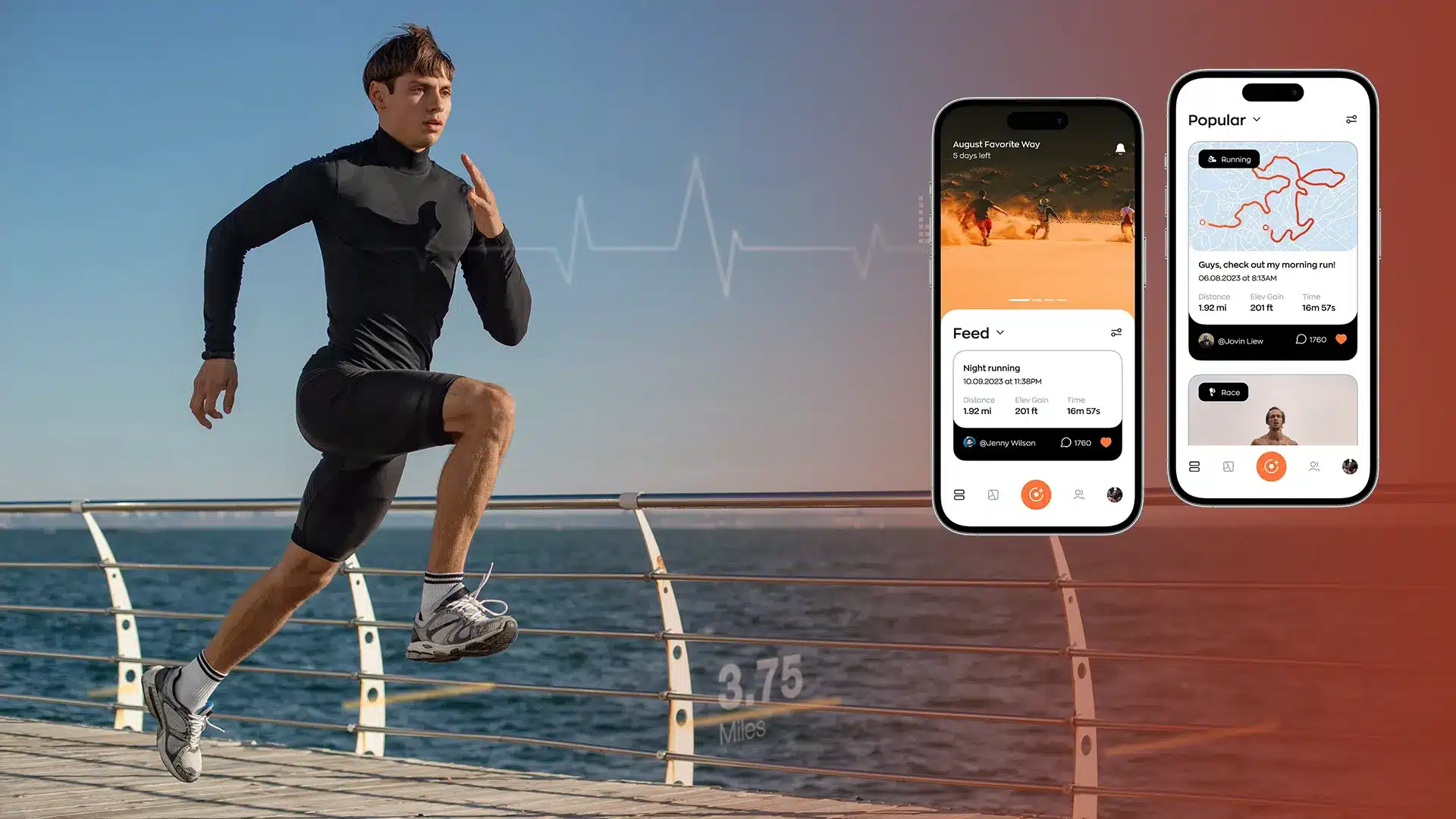Did you imagine a world where your smartphone would be more than just a calling device? Did you imagine it to be your personal coach, activity tracker, and motivator?
Well, that’s all a reality now to millions of users, thanks to the massive growth of fitness apps. According to Grand View Research, the fitness tracking app market is projected to reach $30.63 billion by 2030, growing at a CAGR of 23.5% from 2024 to 2030. This growth is fueled by a growing health-conscious audience that loves progress tracking through a fitness tracking app like Strava.
If you’re a business looking to tap into this thriving sector, you have probably wondered how to develop app like Strava. This guide will walk you through everything — from features and business models to development cost — helping you plan your next big move in the fitness app world.
What is the Strava App?
Strava is a well-known app in the world for fitness tracking among sports enthusiasts, health-conscious individuals, and everyone in between. Strava started as a simple activity tracker in 2009, and now has transitioned into a global social community for joggers, bikers, hikers, swimmers, and other sport lovers.
Strava now offers an extensive range of features and services, and is more than just an app used for tracking distances traveled on foot or a bike; it allows users to track, record, map, analyze, and manage all their activities live. In real time, Strava tracks the distance run, the pace maintained, calories burned, elevation gained and a lot more.
What truly sets Strava apart is its community-driven approach. Through Strava an individual can share workout data, compete in challenges, form clubs, “give kudos”, and even use maps shared by fellow riders for exploring new paths. The modern approach blended with social networking is what gives Strava its edge among other similar fitness tracking applications developed.
How Does the Strava App Work for Users?
Strava combines GPS tracking, real-time data analytics, and social media into a one-of-a-kind fitness app. It doesn’t matter if you are cycling on scenic trails or preparing for a full marathon, Strava records every single detail of your exercise and provides you with meaningful suggestions.
Let us see how the Strava fitness tracking app works:
1. Activity Tracking:
At the start, the user selects an activity such as running, cycling, hiking, or swimming. The app uses GPS to record distance, time, speed, and elevation changes in real time.
2. Data Analysis:
After the workout is complete, the app provides detailed performance analytics. Users can review speed, heart rate (if connected to wearables), route maps, and personal records that allows them to track their progress over time.
3. Community Interaction:
Strava not only allows users to complete workouts but also encourages them to share workout results on their profiles. Users can now give “kudos” or comment on a user’s workout, thus transforming the app from a simple fitness app into a fitness social network.
4. Challenges & Leaderboards:
To boost user motivation, Strava provides both global and local challenges. Within clubs or certain segments, users get ranked for their performance, which is a great way to promote optimism and motivation through healthy competition.
5. Route Discovery:
Users can explore and share routes, making it easier to discover new training paths based on popular routes in the community.
Also Read:
How to Develop an App Like MyfitnessPal?
How to Build an App Like Fitbit?
Benefits of Developing an App Like Strava
As the demand for fitness apps continues to grow, developing an app like Strava provides significant benefits for businesses that are looking to enter the health and fitness space. Here are some key benefits of creating a fitness tracking app like Strava:
1. Growing Market Demand
With the growing popularity of healthy living, the fitness app market is constantly expanding. People are more focused on tracking their workouts, monitoring progress, and engaging in a community of like-minded individuals. Developing an app like Strava means tapping into a large global market that is highly engaged and loyal.
2. Enhanced User Engagement
Strava’s success is in its power to bring users back. The app’s features—challenges, clubs, leaderboards, and social interactions—build a sense of community and friendly competition. Incorporating these features into your fitness app can significantly boost engagement, retention, and popularity.
3. Customization and Analytics
Strava does data tracking regarding users’ activities, allowing them to personalize their workout plans and track improvement. Offering such features in your fitness tracking app can provide users with meaningful insights into their progress. Customers love customized fitness journeys, so such a level of personalization can work well for your app.
4. Revenue Generation
Strava is a fitness app that enables tracking and monitoring of user activities, and therefore opens a variety of monetization opportunities. From selling aggregated user data with consent to hosting sponsored events and subscription fees for premium accounts, there are different ways to unlock revenue. Strava’s success with these strategies suggests that they could also work well for your app.
5. Collaborations and Partnerships
A fitness tracking app like Strava also attracts potential partnerships with fitness organizations, sporting equipment manufacturers, health insurance companies, and even neighborhood gyms. Such partnerships can lend credibility to your app as well as create new sources of income through partnerships or affiliate marketing.
How to Build an App Like Strava? – 6 Easy Steps
Developing a fitness tracking app like Strava requires careful planning, technical expertise, and a strategic approach so that your app meets user expectations. Here’s a simple guide on how to develop an app like Strava in 6 easy steps:
Step 1: Define Your Niche and Core Features
Before you start, it’s important to understand your target audience and the features your fitness tracking app will offer. Strava is popular for running and cycling, but you could expand to other fitness activities such as swimming, hiking, or even yoga. Here are some essential features to consider:
- Tracking activity (via GPS)
- Social sharing (kudos, comments, and activity posts)
- Challenges & leaderboards
- Customized workout plans
- Route discovery
Step 2: Choose the Right Tech Stack
The tech stack you select is essential for the performance, scalability, and security of your app. Strava uses a mix of technologies for its mobile app (iOS and Android) and its backend systems. Some key technologies include:
- Mobile development: Swift (iOS), Kotlin (Android)
- Backend: Node.js, Python (Django)
- Database: PostgreSQL, MongoDB
- Cloud: AWS, Google Cloud
- GPS and mapping: Google Maps API, OpenStreetMap
Step 3: Design the User Interface (UI) and User Experience (UX)
Design plays a huge role in users’ engagement. Strava is known for its clean and intuitive UI and easy navigation through workouts, stats, and social feeds. Ensure that the design is simple, attractive, and user-friendly. Focus on:
- Minimalistic navigation
- Clear, readable graphs and stats
- Real-time activity tracking interface
Step 4: Develop the Core Functionalities
At this stage, you’ll develop the core features, such as:
- GPS-based activity tracking
- Social sharing and community features
- Challenge and leaderboard functionality
- In-app messaging and notifications
Step 5: Test Your App To Fix Bugs and Performance
Before launching, rigorous testing is important. This includes functional testing, performance testing, and user acceptance testing (UAT). You want your app to perform flawlessly under various conditions, such as:
- High server load (during peak usage)
- Multiple simultaneous users on a leaderboard
- Battery efficiency for long workout sessions
Step 6: Launch, Market, and Scale
Once the app is tested and ready, it’s time for launch. But don’t stop there. Use effective marketing strategies to promote your fitness app:
- App Store Optimization (ASO) for visibility
- Influencer partnerships in the fitness niche
- Content marketing (fitness blogs, social media)
- Referral programs and incentives for users who bring in new members
Post-launch, continually monitor performance and user feedback, making improvements based on what your users want.
How Does Strava Make Money?
Strava has created a sustainable business model that utilizes its large user base, fitness data and premium products. Knowing how Strava makes money can give you insights into how to build an app like Strava. Below are the primary ways Strava monetizes its business:
1. Subscription Fees
Strava provides a premium subscription called Strava Summit, which allows users to access features such as:
- In-depth performance analysis (i.e., heart rate zones and power analysis)
- Route planning and scouting
- Live segment comparison (how you compare to past efforts or other users)
- Training plans for specific goals (i.e. training plan for a complete marathon or cycling to increase your speed)
For Strava, the subscription model is its biggest source of revenue, as it allows the company to provide great value for exclusive features, while still allowing a free version for casual users. All value-added services Strava provides are designed to convert free users into paying subscribers.
2. Sponsored Events
Strava generates revenue through partnerships with brands and event organizers to market events. These events can be anything from local fitness challenges and races to fitness-focused media events. Strava’s active user database is a shining opportunity for brands to advertise to and engage fitness enthusiasts.
By running branded challenges or sponsored content, Strava builds user engagement and also generates revenue through partnerships with other fitness brands, sporting goods companies, and even health insurers.
3. Selling Aggregated Data
Strava collects a considerable amount of user data in the form of activity descriptions, routes and activity measurements. This data can be easily anonymized, aggregated and sold, allowing for useful insights for:
- Urban planning (analyzing the popularity of certain routes for city development)
- Marketing and advertising (understanding fitness trends and preferences)
- Research studies (helping scientists study trends in physical activity)
Strava has policies in place where they can sell this data to individuals and firms such as urban planners, research organizations, or manufacturers of fitness sustaining goods. Income from selling anonymized data is also a significant source of revenue, however anonymization is a sensitive subject as it needs to be protective of the privacy of users.
Cost to Create a Fitness App Like Strava
Here’s an estimated breakdown of the cost to develop an app like Strava based on the complexity of its features:
| Features | Estimated Cost |
|---|---|
| Basic Fitness Tracking Features | $30,000 – $50,000 |
| Advanced Performance Analytics | $50,000 – $80,000 |
| Social Features & Leaderboards | $20,000 – $40,000 |
| Subscription Integration | $10,000 – $20,000 |
| Backend Development & Cloud Hosting | $25,000 – $50,000 |
| Testing & QA | $10,000 – $15,000 |
| UI/UX Design | $15,000 – $30,000 |
| Total Estimated Cost (Basic to Advanced) | $80,000 – $250,000 |
Factors That Affect the Cost
1. Platform Selection
Developing for multiple platforms (iOS, Android, Web) will increase the cost. A basic fitness app on one platform may cost less than building it for both iOS and Android.
2. Features and Functionalities
The number of features you want to offer also impacts cost. Important features like GPS, live analytics, social integration, challenges, and performance analytics will require advanced coding and ultimately impact your overall development cost.
3. Design and User Interface
Designing a great UI/UX is essential to entice users and keep them engaged. Great design work adds to the cost of developing your app, but should be valued because it drives user retention numbers.
4. Development Team Expertise
The experience and geography of the development team will also impact cost. Developers from the US or Western Europe generally charge a higher rate than those in Eastern Europe and India, but will vary in quality and ability to communicate, etc
5. Backend and Infrastructure
To handle real-time data and the aggregate amount of user-generated content (activity tracker data, etc), you’ll need a solid backend infrastructure, which can also add costs. Keeping data at scale is manageable using AWS or Google Cloud, but it will add to the operational costs.
6. Testing and QA
Exhaustive testing is critical in making sure your fitness app is performing well, especially in a high-use environment. Testing (which includes functional, performance, and user acceptance testing) is going to add some costs, but will help you launch a stable app
Additional Costs to Consider
App Maintenance: Regular updates, bug fixes, and server maintenance will add ongoing costs (typically 15-20% of the initial development cost per year).
Marketing: Launching and promoting the app will require an additional budget for advertising, influencer partnerships, and app store optimization.
Pro Tip: To reduce costs, consider launching a Minimum Viable Product (MVP) version of your fitness app with some must-have features first. You can then gradually introduce advanced functionalities based on user feedback
Features to Develop an App Like Strava
When you create an application like Strava, you need to create the right features to drive real value for users while helping you stand out from the competitors in the app ecosystem. Following are the key features you should include in your fitness tracking app:
1. User Profile & Personalization
You should collect user profiles to enable fitness users to track their fitness goals, achievements, and progress. By leveraging components for personalization such as avatars, fitness goals (distance, calories, etc), and activity logs, users can experience more engagement
2. Tracking Activity
Activity features and tracking are the foundation of any fitness app. It is imperative to be able to provide GPS tracking to be able to map out routes for cycling, running, or walking. You can also start pulling in sensors for items such as heart rate monitors, speed sensors, and cadence sensors to enable a more in-depth data set for their overall workout.
3. Social Features
Strava does a great job of integrating social features. Users can share their workouts, connect with friends, join fitness challenges, and even check their results against other participants. All of this keeps users inspired and engaged. Consider including:
- Activity feed (similar to social media)
- Friendship & social interaction (following friends, commenting, liking posts)
- Leaderboards & challenges (weekly/monthly competitions)
4. Performance Analytics
Advanced analytics are a crucial feature of a fitness activity tracking app. Provide detailed insights such as:
- Pace, speed, and time analysis
- Calories burned, heart rate zone
- Elevation gain and distance covered
These features will appeal to more serious athletes and fitness buffs who are looking to optimize their performance.
5. Route Planning & Discovery
Give users the ability to plan their workouts. You can include features that suggest popular routes nearby based on the user’s current location, adding more value to the experience and an opportunity for exploration. You can even let users share their routes for others to use.
6. In-App Messaging & Notifications
Include an in-app messaging service or notifications to inform users of new challenges, accomplishments, or when any of their friends complete activities. Real-time notifications are the best way to keep users coming back to the app when they see notifications about friends doing activities or upcoming events!
7. Subscription Management & Premium Features
To make your fitness app profitable, integrate key features that are part of a premium subscription:
- Exclusive workout plans
- Advanced analytics and stats
- No ads experience. This could be part of a tiered subscription model like Strava’s Strava Summit, offering
- users more value at different price points.
8. Integration with Wearables
Strava works well with the common fitness trackers and wearables that users already utilize to stay fit, like Fitbit, Garmin, Apple Watch, and Polar. Like Strava, your fitness tracking app should support syncing to third-party fitness devices to import users’ activities along with their health data automatically.
9. Gamification Features
To motivate users, add gamification elements like:
- Badges for achieving milestones (e.g., running a 5k, completing a month of daily workouts)
- Points and rewards for completing challenges or daily activities
- Social sharing of these achievements on social media encourages friendly competition
10. Offline Functionality
Another app’s functionality enables users to monitor their activities even when there’s no internet. Strava, for example, records the activity offline and then syncs once the user has internet again.
11. Data Privacy & Security
Fitness apps collect sensitive user data such as location and health statistics. Ensure compliance with data protection regulations (e.g., GDPR, HIPAA), make sure user data is encrypted and and stored properly.
Why NineHertz is a Leading Fitness App Development Company for Building Apps Like Strava?
Selecting the best fitness app development company to create a powerful and scalable fitness app like Strava is imperative. NineHertz is a trusted name in building high-performing fitness tracking apps for startups to enterprises. Here’s why NineHertz is trusted by businesses:
1. Proven Expertise in Fitness App Development
Years of experience developing fitness apps have given the NineHertz team an in-depth understanding of the relevant technical requirements and user needs for creating a fitness app similar to Strava. Our developers provide a clean, seamless, reliable user experience, whether it is real-time GPS tracking or detailed performance analytics.
2. End-to-End Development Solutions
NineHertz can help whether you want to verify an idea, create a prototype, or develop a full-featured fitness tracking app. We have the end-to-end solution in UI/UX design, backend creation, API integrations, and post-launch support.
3. Integration with Wearables & IoT Devices
Our developers specialize in linking fitness apps with many wearable devices – Apple Watch, fitness bands like Fitbit, Garmin, and many others – so they can track their physical activity indoors or outdoors!
4. Customized Business Models & Scalable Architecture
We build fitness apps with flexibility so you can leverage monetizing opportunities such as memberships, in-app purchases, sponsored events, etc., while ensuring your app has the capability to grow with your user base.
5. Client-Centric Approach & Agile Delivery
At NineHertz, we value open communication and agile processes. Our team works alongside our clients every step of the way, from ideation to launch. You can trust us to deliver a custom solution on time and on budget.
Conclusion
The popularity of fitness apps like Strava has changed how people think about health, workouts, and social fitness challenges. Whether it’s runners tracking their best timing, cyclists mapping scenic routes, or fitness enthusiasts connecting with like-minded communities, apps like Strava are driving the future of digital fitness.
If you’re planning to develop an app like Strava, now is the best time to build a powerful, consumer-friendly, and scalable app than ever before. There are countless advanced features that can be included in your fitness tracking application (e.g., GPS mapping, performance metrics, etc.) and community user features that all appeal to the modern fitness user! TikTok, Instagram and Youtube are full of fitness users showing off their cool workouts and are often shared on Strava!
Partnering with a trusted fitness tracking app development company like NineHertz ensures your idea is in expert hands. Our team specifically focuses on building premium fitness applications that perform well, look great and give you the best business value.
Frequently Asked Questions
1. How do I develop an app like Strava?
To develop an app like Strava, start by planning core features like GPS tracking, analytics, and social sharing. Then hire a skilled fitness app development company like NineHertz to build, test, and launch your app.
2. How much does it cost to develop a fitness tracking app like Strava?
The cost typically ranges from $30,000 to $150,000, depending on fitness features, platforms, and development team location.
3. Why should I invest in fitness app development in 2025?
The global demand for fitness apps is booming as more users prioritize health and digital convenience. Investing now offers strong growth potential and recurring revenue through subscriptions and in-app features.
4. Which company is best for developing a fitness app like Strava?
If you’re planning to develop an app like Strava, healthcare app development company like NineHertz is a trusted partner for designing and building scalable, feature-rich fitness apps tailored to your business goals.
Great Together!






![How to Create an App like Careem? [Cost in 2025]](https://theninehertz.com/wp-content/uploads/2024/09/how-to-create-an-app-like-careem.webp)






